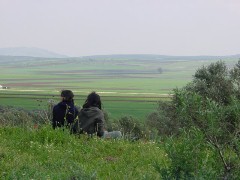  The
sounds of Zababdeh: The
sounds of Zababdeh:
4:45 AM, Muslim prayer (40 sec.) 6:00 AM, Church bells (40 sec.) 6:30 AM, sheep 7:30 AM, National Anthem (40 sec.) 24-7, Electrical generator (5 sec.) All night long, cow (14 sec.) Night-time, shooting (5 sec.) |
 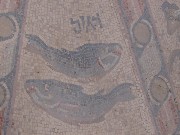  4/1/01:
After Elizabeth's adult classes, we left with the family for a few days
in the Galilee district. Nevertheless, visits had already begun -
our friends in Zababdeh were quite insistent on seeing "abouk, immak, ou
ukhtak" (your father, mother, and sister) for a little coffee or tea.
We spent the night in the Jaffa area of Nazareth, staying at The Harbour
ministries. After there was a brief recovery for jetlag, we headed
off for a day in Tiberias. We'll save you the details of the car
problems, but suffice it to say that this seems to be becoming a recurring
part of the narrative. Once there, we spent most of the day walking
and seeing historic sites - the mosques of the Old City (no Palestinians
live in Tiberias any more, leaving the buildings abandoned. They
were also targeted in anti-Arab riots early in the Intifada) and
St. Peter's Franciscan Church in particular. Peter became a disciple
"straight off the boat," and so the church there honors his previous profession
architecturally within view of the sea. We then visited one of 4/1/01:
After Elizabeth's adult classes, we left with the family for a few days
in the Galilee district. Nevertheless, visits had already begun -
our friends in Zababdeh were quite insistent on seeing "abouk, immak, ou
ukhtak" (your father, mother, and sister) for a little coffee or tea.
We spent the night in the Jaffa area of Nazareth, staying at The Harbour
ministries. After there was a brief recovery for jetlag, we headed
off for a day in Tiberias. We'll save you the details of the car
problems, but suffice it to say that this seems to be becoming a recurring
part of the narrative. Once there, we spent most of the day walking
and seeing historic sites - the mosques of the Old City (no Palestinians
live in Tiberias any more, leaving the buildings abandoned. They
were also targeted in anti-Arab riots early in the Intifada) and
St. Peter's Franciscan Church in particular. Peter became a disciple
"straight off the boat," and so the church there honors his previous profession
architecturally within view of the sea. We then visited one of  the
oldest sites in Tiberias, the hot springs which have had visitors for thousands
of years. After soaking up some history and musing over the ancient
synagogue mosaic with pagan zodiac symbols in the floor, we soaked up some
of the hot springs and were bruised by large Russian masseusses and masseurs.
All five of us. Toasty. Our day of rampant tourism was capped
off by dinner in Jaffa at an "authentic Bedouin restaurant" - just like
they used to have back in the old days. the
oldest sites in Tiberias, the hot springs which have had visitors for thousands
of years. After soaking up some history and musing over the ancient
synagogue mosaic with pagan zodiac symbols in the floor, we soaked up some
of the hot springs and were bruised by large Russian masseusses and masseurs.
All five of us. Toasty. Our day of rampant tourism was capped
off by dinner in Jaffa at an "authentic Bedouin restaurant" - just like
they used to have back in the old days. |
  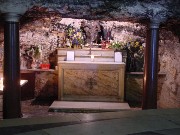 4/2/01:
Marthame ferried Elizabeth back to Zababdeh so that she could conscientiously
teach while Marthame played hooky with the family. Our trips across
the Green Line have become more frequent as of late, which is good since
the soldiers there are new and don't know our faces yet. By the time
Marthame returned to Jaffa, the familywas in the middle of their first
cup of coffee and a plan was hatched to spend the rest of the day in Haifa.
Our first stop was the magnificent Baha'i Temple (video
- 27 sec). This is the central temple for that faith throughout the
world. One of the others is in Wilmette, Illinois, within blocks
of our old house, but the multi-tiered gardens here overlooking the Mediterranean
leave all other temples in their wake. We then continued up Mt. Carmel
to the Monastery and Church of Elijah, built over the traditional site
of his former grotto residence, before heading down to find the cave where
he prepared to take 4/2/01:
Marthame ferried Elizabeth back to Zababdeh so that she could conscientiously
teach while Marthame played hooky with the family. Our trips across
the Green Line have become more frequent as of late, which is good since
the soldiers there are new and don't know our faces yet. By the time
Marthame returned to Jaffa, the familywas in the middle of their first
cup of coffee and a plan was hatched to spend the rest of the day in Haifa.
Our first stop was the magnificent Baha'i Temple (video
- 27 sec). This is the central temple for that faith throughout the
world. One of the others is in Wilmette, Illinois, within blocks
of our old house, but the multi-tiered gardens here overlooking the Mediterranean
leave all other temples in their wake. We then continued up Mt. Carmel
to the Monastery and Church of Elijah, built over the traditional site
of his former grotto residence, before heading down to find the cave where
he prepared to take  on
the prophets of Ba'al (I Kings 18). The latter is a synagogue (video
- 19 sec.), and Marthame and Alecia (his sister) found that it was locked.
The gate provided a nice stepladder, though, and they made their own pilgrimage
anyway. After enjoying the spectacular view over Haifa from Mt. Carmel,
we headed back to Jaffa to enjoy food cooked by "Victor the Redhead" -
just like they used to have in the old days. on
the prophets of Ba'al (I Kings 18). The latter is a synagogue (video
- 19 sec.), and Marthame and Alecia (his sister) found that it was locked.
The gate provided a nice stepladder, though, and they made their own pilgrimage
anyway. After enjoying the spectacular view over Haifa from Mt. Carmel,
we headed back to Jaffa to enjoy food cooked by "Victor the Redhead" -
just like they used to have in the old days. |
   4/3/01:
Today we confined ourselves to the Old City of Nazareth. First stop
was Al-Bishara, the Latin Basilica of the Annunciation, with its mosaics
of Mary and the infant Jesus taken from around the world. Just a
stone's throw away is St. Joseph's Church, believed to be the site of his
carpentry shop. There we discovered a group of French pilgrims, whose
singing helped add to the feel of the place (video
- 12 sec.). After a quick lunch and a brisk walk, we visited Mary's
Well (audio - 5 sec.) and the Greek Orthodox
St. Gabriel's Church (video - 22 sec.),
their preferred site of the annunciation. Of course, in the end,
no one knows which is the right one, but sharing is apparently out of the
question. We headed back to Zababdeh so Marthame wouldn't be docked
for playing hooky and so that we could spend a few days basking in authentic
Semitic village hospitality - just like they used to have in the old days. 4/3/01:
Today we confined ourselves to the Old City of Nazareth. First stop
was Al-Bishara, the Latin Basilica of the Annunciation, with its mosaics
of Mary and the infant Jesus taken from around the world. Just a
stone's throw away is St. Joseph's Church, believed to be the site of his
carpentry shop. There we discovered a group of French pilgrims, whose
singing helped add to the feel of the place (video
- 12 sec.). After a quick lunch and a brisk walk, we visited Mary's
Well (audio - 5 sec.) and the Greek Orthodox
St. Gabriel's Church (video - 22 sec.),
their preferred site of the annunciation. Of course, in the end,
no one knows which is the right one, but sharing is apparently out of the
question. We headed back to Zababdeh so Marthame wouldn't be docked
for playing hooky and so that we could spend a few days basking in authentic
Semitic village hospitality - just like they used to have in the old days. |
  4/4/01:
The visiting marathon begins - so many friends and families to see, so
little time! There is a little too much Disney here for comfort,
which means Alecia's travels all the way from Orlando to this small Palestinian
village have vainly tried to escape Uncle Walt. It is days like this
that you begin to realize that there's only so much coffee and caffeine
one can ingest. Some of the families we visit use an impressive amount
of English, which delights and amazes Marthame's family. Others speak
a few words, and it is up to us to translate - which frightens and amuses
Marthame's family. Even so, it is a good chance to realize how much
Arabic we have actually learned over the previous seven months. But
there's still a long way to go! 4/4/01:
The visiting marathon begins - so many friends and families to see, so
little time! There is a little too much Disney here for comfort,
which means Alecia's travels all the way from Orlando to this small Palestinian
village have vainly tried to escape Uncle Walt. It is days like this
that you begin to realize that there's only so much coffee and caffeine
one can ingest. Some of the families we visit use an impressive amount
of English, which delights and amazes Marthame's family. Others speak
a few words, and it is up to us to translate - which frightens and amuses
Marthame's family. Even so, it is a good chance to realize how much
Arabic we have actually learned over the previous seven months. But
there's still a long way to go! |
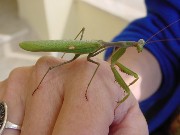  4/6/01:
Since it's Friday, it gave us the chance to walk around the hills near
the new Arab-American University of Jenin.
As we've said before about it, there are tremendous views and there are
always new plants and trees and wildlife to learn about. In particular,
we saw the locust bean tree - the one referred to in the gospels when it
says that John the Baptist was subsisting on honey and wild locusts (not
the insect, but the bean). We also learned that the spectacular red
flowers which we've featured throughout our journal before are the "lilies
of the field" Jesus preached about. After a picnic, we headed back
to Zababdeh to fulfill more social obligations and to impress everyone
with Alecia's Arabic level ("three days and she speaks better than you!"
we are told). Ah, how a little goes a long way... 4/6/01:
Since it's Friday, it gave us the chance to walk around the hills near
the new Arab-American University of Jenin.
As we've said before about it, there are tremendous views and there are
always new plants and trees and wildlife to learn about. In particular,
we saw the locust bean tree - the one referred to in the gospels when it
says that John the Baptist was subsisting on honey and wild locusts (not
the insect, but the bean). We also learned that the spectacular red
flowers which we've featured throughout our journal before are the "lilies
of the field" Jesus preached about. After a picnic, we headed back
to Zababdeh to fulfill more social obligations and to impress everyone
with Alecia's Arabic level ("three days and she speaks better than you!"
we are told). Ah, how a little goes a long way... |
 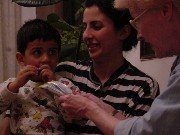 4/7/01:
This morning we received a call from a friend in Beit Jala, telling us
she had heard that Zababdeh had been hit by Israeli tank fire the night
before. We chalked it up to the Arabic telephone, since we had only
heard a little shooting last night, nothing out of the ordinary.
But when people in Beit Jala are worried about your well-being, that's
saying something. We continued our rounds of the village, discovering
that people are getting ready for Palm Sunday tomorrow (in Arabic, "'Eid
as-Shaianiin" - literally, the festival of olive branches). Their
palm branches are folded in incredible patterns, made to support flower
displays and the like. 4/7/01:
This morning we received a call from a friend in Beit Jala, telling us
she had heard that Zababdeh had been hit by Israeli tank fire the night
before. We chalked it up to the Arabic telephone, since we had only
heard a little shooting last night, nothing out of the ordinary.
But when people in Beit Jala are worried about your well-being, that's
saying something. We continued our rounds of the village, discovering
that people are getting ready for Palm Sunday tomorrow (in Arabic, "'Eid
as-Shaianiin" - literally, the festival of olive branches). Their
palm branches are folded in incredible patterns, made to support flower
displays and the like. |
 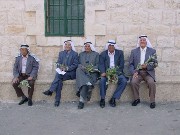  4/8/01:
Happy Palm Sunday! The Catholics and Anglicans joined together at
8:30 for their procession around the village. After some brief liturgy
in front of the Latin Church (video - 10
sec.), including the blessing of the branches, we began our own "Hosanna"
procession around the village (video -
21 sec.). When we reached the Anglican church, their community split off
from the parade to continue their service. We headed back to the
Latin Church, where we knocked at the church doors three times before they
were opened by the waiting congregation inside. The church was so
crowded that Marthame's folks ended up sitting on the steps of the school
outside, objects of a great deal of curiosity, as they admired the Rosary
Sisters' control of the youth. Usually, Palm Sunday isn't a very big event
within the village, as most of the Christian communities in Palestine head
down to Jerusalem for the large procession from Bethpage into the Old City.
This year, though, travel was impossible. The Israelis said that,
rather than the usual 4/8/01:
Happy Palm Sunday! The Catholics and Anglicans joined together at
8:30 for their procession around the village. After some brief liturgy
in front of the Latin Church (video - 10
sec.), including the blessing of the branches, we began our own "Hosanna"
procession around the village (video -
21 sec.). When we reached the Anglican church, their community split off
from the parade to continue their service. We headed back to the
Latin Church, where we knocked at the church doors three times before they
were opened by the waiting congregation inside. The church was so
crowded that Marthame's folks ended up sitting on the steps of the school
outside, objects of a great deal of curiosity, as they admired the Rosary
Sisters' control of the youth. Usually, Palm Sunday isn't a very big event
within the village, as most of the Christian communities in Palestine head
down to Jerusalem for the large procession from Bethpage into the Old City.
This year, though, travel was impossible. The Israelis said that,
rather than the usual  blanket
permission to Christians for Palm Sunday, each person would have to apply
individually for the benefit of worshipping together. Marthame and
his family were able to travel down, after some snide remarks from the
Israeli soldiers at the checkpoint (a first at this particular checkpoint),
arriving at the blanket
permission to Christians for Palm Sunday, each person would have to apply
individually for the benefit of worshipping together. Marthame and
his family were able to travel down, after some snide remarks from the
Israeli soldiers at the checkpoint (a first at this particular checkpoint),
arriving at the  Mount
of Olives just in time for the procession. Catholics and Protestants
(again, no Orthodox) joined together for the parade (video
- 13 sec.). Because of the travel restrictions, internationals far
outnumbered the locals, and they came from an impressive array of countries.
Even so, some of our Zababdeh friends managed to make the journey, though
they were the ones who had been living in or near Jerusalem already.
As we entered St. Stephen's Gate, we noticed the Israeli soldiers poised
on the top of the gate (video - 23 sec.).
This has been the scene of many clashes over the past months between Palestinian
youth and Israeli soldiers and police. Their presence was to be one
of protection, but we couldn't help but feel more threatened by the presence
of M-16s than we might have by their absence. We made our way through
the Old City to our hotel at Jaffa Gate, where we discovered that two youth
from Zababdeh are working! Following the post-Christmas slump, they
had returned to pick up some money from the slightly-revived Easter season. Mount
of Olives just in time for the procession. Catholics and Protestants
(again, no Orthodox) joined together for the parade (video
- 13 sec.). Because of the travel restrictions, internationals far
outnumbered the locals, and they came from an impressive array of countries.
Even so, some of our Zababdeh friends managed to make the journey, though
they were the ones who had been living in or near Jerusalem already.
As we entered St. Stephen's Gate, we noticed the Israeli soldiers poised
on the top of the gate (video - 23 sec.).
This has been the scene of many clashes over the past months between Palestinian
youth and Israeli soldiers and police. Their presence was to be one
of protection, but we couldn't help but feel more threatened by the presence
of M-16s than we might have by their absence. We made our way through
the Old City to our hotel at Jaffa Gate, where we discovered that two youth
from Zababdeh are working! Following the post-Christmas slump, they
had returned to pick up some money from the slightly-revived Easter season. |
   4/9/01:
Today was a quiet day, nice and slow. We traveled the Via Dolorosa,
visiting both the impressive churches along the way (like the Church of
Flaggelation with its impressive ceiling artwork of the crown of thorns)
and the small chapels that simply mark one of the Stations of the Cross.
One of the highlights was the Coptic Monastery, resting next to the Holy
Sepulchre. Down below is the cave of St. Helena, which invites visitors
to sing hymns and appreciate the acoustics. We couldn't resist dropping
off a few Easter Hymns, and Marthame's mom's and sister's voices were multiplied
into a choir (audio - 40 sec.). After
a quick visit to the Holy Sepulchre, we went to St.
James' Armenian Orthodox Cathedral for their daily dose of smells and
bells (video - 25 sec.). It begins
with one of the priests knocking against a piece of wood (audio
- 5 sec.) - there's nothing quite like it for Old World mystery in the
Old City. We eventually wound our way 4/9/01:
Today was a quiet day, nice and slow. We traveled the Via Dolorosa,
visiting both the impressive churches along the way (like the Church of
Flaggelation with its impressive ceiling artwork of the crown of thorns)
and the small chapels that simply mark one of the Stations of the Cross.
One of the highlights was the Coptic Monastery, resting next to the Holy
Sepulchre. Down below is the cave of St. Helena, which invites visitors
to sing hymns and appreciate the acoustics. We couldn't resist dropping
off a few Easter Hymns, and Marthame's mom's and sister's voices were multiplied
into a choir (audio - 40 sec.). After
a quick visit to the Holy Sepulchre, we went to St.
James' Armenian Orthodox Cathedral for their daily dose of smells and
bells (video - 25 sec.). It begins
with one of the priests knocking against a piece of wood (audio
- 5 sec.) - there's nothing quite like it for Old World mystery in the
Old City. We eventually wound our way  to
the Western Wall, stopping in the Jewish Quarter for lunch (but no sandwiches
- it's Passover). Lunch offered the opportunity to do some crowd-watching,
marveling at the various attires found among the population of Jerusalem's
Jewish section. There are soldiers whose machine guns rest on their
laps; ultra-Orthodox men with silk dresses and large, fur hats; Orthodox
women with simple headcoverings; secular young women with belly shirts,
dyed hair, and pierced eyebrows - all sitting side by side in the cafes.
We tried, once again in vain, to visit the Dome of the Rock. It is
closed to non-Muslims for the foreseeable future (as it once was many years
ago), as the Islamic Waqf in charge of the property has become nervous
about what an open visiting policy might lead to (e.g. Mr. Sharon).
We dined with friends in the New City, enjoying the fact that we choice
a dairy rather than meat restaurant as we gulped down our ice cream. to
the Western Wall, stopping in the Jewish Quarter for lunch (but no sandwiches
- it's Passover). Lunch offered the opportunity to do some crowd-watching,
marveling at the various attires found among the population of Jerusalem's
Jewish section. There are soldiers whose machine guns rest on their
laps; ultra-Orthodox men with silk dresses and large, fur hats; Orthodox
women with simple headcoverings; secular young women with belly shirts,
dyed hair, and pierced eyebrows - all sitting side by side in the cafes.
We tried, once again in vain, to visit the Dome of the Rock. It is
closed to non-Muslims for the foreseeable future (as it once was many years
ago), as the Islamic Waqf in charge of the property has become nervous
about what an open visiting policy might lead to (e.g. Mr. Sharon).
We dined with friends in the New City, enjoying the fact that we choice
a dairy rather than meat restaurant as we gulped down our ice cream. |
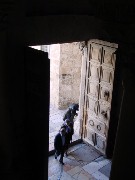 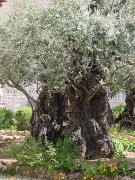 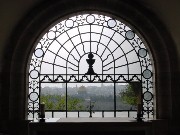 4/10/01:
Since we had given short shrift to the Holy Sepulchre yesterday, today
we gave it the time it deserves. From there, we made an aborted attempt
to visit the Protestant Garden Tomb and the Mount of Olives. Between
car troubles, closed roads for Passover, road construction, and an inaccurate
street map, we decided we were better off hiring a taxi and leaving the
car at the hotel. The Old City was closed to cars for "security reasons,"
but Marthame managed to argue his way past the police. Our taxi driver
then took us on a rapid-fire visit to the sites on the Mount of Olives.
We marveled at the 2000 year-old olive trees in the Garden of Gethsemane,
witnesses to whatever happened that fateful Thursday night so long ago.
The Churches (one Catholic, one Russian) and Mosque (!) of the Ascencion
were all closed, unfortunately, as was the sanctuary of Pater Noster (the
Lord's Prayer) - though their courtyard was open. The church of Dominus
Flevit ("The Lord wept") was open, though, providing a spectacular, unparalleled
view of the Old City over the altar. Somehow, the words Jesus spoke
here seem 4/10/01:
Since we had given short shrift to the Holy Sepulchre yesterday, today
we gave it the time it deserves. From there, we made an aborted attempt
to visit the Protestant Garden Tomb and the Mount of Olives. Between
car troubles, closed roads for Passover, road construction, and an inaccurate
street map, we decided we were better off hiring a taxi and leaving the
car at the hotel. The Old City was closed to cars for "security reasons,"
but Marthame managed to argue his way past the police. Our taxi driver
then took us on a rapid-fire visit to the sites on the Mount of Olives.
We marveled at the 2000 year-old olive trees in the Garden of Gethsemane,
witnesses to whatever happened that fateful Thursday night so long ago.
The Churches (one Catholic, one Russian) and Mosque (!) of the Ascencion
were all closed, unfortunately, as was the sanctuary of Pater Noster (the
Lord's Prayer) - though their courtyard was open. The church of Dominus
Flevit ("The Lord wept") was open, though, providing a spectacular, unparalleled
view of the Old City over the altar. Somehow, the words Jesus spoke
here seem  more
relevant than ever - "If you had only recognized the things that make for
peace. But now, they are hidden from your eyes." (Luke 19: 42)
We finished our tour of the Mount at the Russian Orthodox Covent of Mary
Magdalene, with its beautiful golden onion domes, meeting one of the sisters
who was born and raised in Zababdeh. Returning back to the Old City,
we stopped at the Latin Patriarchate of Jerusalem
to visit with friends (Marthame's mom's reply on meeting the Patriarch
himself: "Wow!") and to see the cathedral before giving ourselves a chance
to rest. It's supposed to be vacation, you know. more
relevant than ever - "If you had only recognized the things that make for
peace. But now, they are hidden from your eyes." (Luke 19: 42)
We finished our tour of the Mount at the Russian Orthodox Covent of Mary
Magdalene, with its beautiful golden onion domes, meeting one of the sisters
who was born and raised in Zababdeh. Returning back to the Old City,
we stopped at the Latin Patriarchate of Jerusalem
to visit with friends (Marthame's mom's reply on meeting the Patriarch
himself: "Wow!") and to see the cathedral before giving ourselves a chance
to rest. It's supposed to be vacation, you know. |
 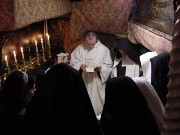 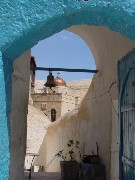 4/11/01:
We headed off to Bethlehem today, giving Marthame's family a chance to
experience first-hand what life under occupation is like, as they crossed
over a blockaded road to meet our waiting taxi. Unfortunately, our
taxi drivers were under the impression that we were big money tourists
ready to be theirs for the next five hours - shopping, ferrying, etc. -
and were noticeably disappointed when we asked to be dropped off and would
call them when we were ready to leave. We headed first to the Church
of the Nativity, whose grotto was more crowded than any time - including
Christmas - since we've visited. We met up with a couple of Zababdeh
friends (of course) who are studying to be tour guides at Bethlehem University.
The tour guides waiting around the Nativity Church had to be informed that
a fourth guide (Marthame as #3) would be a bit unnecessary. We visited
the Bethlehem Museum, getting a glimpse
at life over the last few centuries in Bethlehem, before hiring a taxi
out to Mar Saba Monastery. We had been told that they would only
let Orthodox Christians in (and we knew they would only let men in), so
we led with our Orthodox Zababdeh friend. Marthame also removed his
clerical collar so as not to confuse the issue. In the end, all of
the men were permitted inside, 4/11/01:
We headed off to Bethlehem today, giving Marthame's family a chance to
experience first-hand what life under occupation is like, as they crossed
over a blockaded road to meet our waiting taxi. Unfortunately, our
taxi drivers were under the impression that we were big money tourists
ready to be theirs for the next five hours - shopping, ferrying, etc. -
and were noticeably disappointed when we asked to be dropped off and would
call them when we were ready to leave. We headed first to the Church
of the Nativity, whose grotto was more crowded than any time - including
Christmas - since we've visited. We met up with a couple of Zababdeh
friends (of course) who are studying to be tour guides at Bethlehem University.
The tour guides waiting around the Nativity Church had to be informed that
a fourth guide (Marthame as #3) would be a bit unnecessary. We visited
the Bethlehem Museum, getting a glimpse
at life over the last few centuries in Bethlehem, before hiring a taxi
out to Mar Saba Monastery. We had been told that they would only
let Orthodox Christians in (and we knew they would only let men in), so
we led with our Orthodox Zababdeh friend. Marthame also removed his
clerical collar so as not to confuse the issue. In the end, all of
the men were permitted inside,  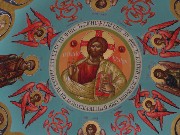 including
our Muslim driver. This monastery, built in the 6th century by 5000
pilgrims following St. Saba into the wilderness, stands on the edge of
the Kidron Valley, overlooking the Kidron River (video
- 13 sec.). There are now only fourteen monks, most of them from
Greece, taking care of its pristine monastic life-style. Most of
the visitors these days are Greeks themselves. Within the monastery
is a church which contains the body of St. Saba (after its return from
Venice by the Catholic church in the 1960s). Overlooking the river,
you can see the caves where St. Saba and his followers once lived out their
monastic life. It was well-worth the trip (video
- 20 sec.), even for Marthame's mom and sister who had to wait outside
for our male-bonding. We took a quick walk through Bethlehem's Souq
(market) before heading back to Jerusalem. Once there, Marthame,
his sister, and his mom headed off to the Protestant
Garden
Tomb, run by the British, and purported to potentially be the site
of the crucifixion and resurrection. They do emphasize, however,
the central tenet of Christianity - "He is not here. He is risen."
This could stand as some words of correction for those of us who use the
term "Holy Land" so freely. We wandered our way back through the
old Souq, marveling at Alecia's ability to bargain, before joining friends
in the New City for some dessert and conversation. including
our Muslim driver. This monastery, built in the 6th century by 5000
pilgrims following St. Saba into the wilderness, stands on the edge of
the Kidron Valley, overlooking the Kidron River (video
- 13 sec.). There are now only fourteen monks, most of them from
Greece, taking care of its pristine monastic life-style. Most of
the visitors these days are Greeks themselves. Within the monastery
is a church which contains the body of St. Saba (after its return from
Venice by the Catholic church in the 1960s). Overlooking the river,
you can see the caves where St. Saba and his followers once lived out their
monastic life. It was well-worth the trip (video
- 20 sec.), even for Marthame's mom and sister who had to wait outside
for our male-bonding. We took a quick walk through Bethlehem's Souq
(market) before heading back to Jerusalem. Once there, Marthame,
his sister, and his mom headed off to the Protestant
Garden
Tomb, run by the British, and purported to potentially be the site
of the crucifixion and resurrection. They do emphasize, however,
the central tenet of Christianity - "He is not here. He is risen."
This could stand as some words of correction for those of us who use the
term "Holy Land" so freely. We wandered our way back through the
old Souq, marveling at Alecia's ability to bargain, before joining friends
in the New City for some dessert and conversation. |
|
4/12/01: A Blessed Maundy Thursday. Marthame tried to get the car fixed, once and for all, in Ramallah - to no avail. He left it with friends in the New City and rented a car instead to deal with the next week of shuttlings - a lot less stressful in the end. The Palestinian owner of the rental company had spent some time in New York and had picked up an accent along the way. ("You got ya' A/C ovah he-ah") Marthame's family headed off the Tel Aviv to enjoy a few days along the beach while Marthame headed back to Zababdeh, arriving just in time for the Latin Church's evening service (but too late for the Anglican one). The service begins with a full procession, including all of the grooms from the previous year's weddings. Following the homily, Abuna Louis washed the feet of these grooms. Why they grooms? Well, we're not really sure. One thing that stood out in particular was the presence of three altar boys who had been studying at the Latin Seminary in Beit Jala. Their presence meant that the liturgical part of the service ran like clockwork. It was an impressive piece of work. |
   4/13/01:
There were two Good Friday services at the Latin (Roman Catholic) church
today (called "Sad Friday" in Arabic). In the morning, the Latin
faithful gathered - as they did every Friday during Lent - for a Stations
of the Cross walk around the church. Since the church is surrounded
by the school, this meant going around and through the school for the fourteen
stations. In the afternoon, beginning at 4:00, was the large service.
The whole worship was centered around readings and chantings of scripture
passages. Many, many beautiful voices, but the highlight was one
particularly moving and very eastern piece (audio
- 23 sec. - the picture's sideways, but the sound's not). Three
men sang the gospel passage (John 19-20) together, taking different parts.
Tremendously powerful. As the large crucifix was brought out, people
came forward to kiss it. We mistakenly assumed this would be in place
of the eucharist, since there is traditionally no mass on Good Friday.
Instead, bread was distributed, but there were no words of institution
since it was taken from the reserved sacrament. Lying on a large
table in front of the altar was a large cross, and as Abuna Louis shrouded
it in incense, girls sprayed perfume - a symbol of preparation for burial.
The procession then headed to the village's Christian cemetary, where the
cross was set for the night. Elizabeth noted the large number of
people who gathered at family gravesides and weeped and mourned demonstratively
over the departed. While some of the service was new and strange to us,
we were both very moved by its beauty and power. Afterwards, we made a
fast dash in the rental car down to Tel Aviv to meet up with Marthame's
family for dessert and birthday celebrations (Mom and Dad's days are just
around the corner) before their early, early, early morning flight tomorrow.
A busy day, but worth the trip. 4/13/01:
There were two Good Friday services at the Latin (Roman Catholic) church
today (called "Sad Friday" in Arabic). In the morning, the Latin
faithful gathered - as they did every Friday during Lent - for a Stations
of the Cross walk around the church. Since the church is surrounded
by the school, this meant going around and through the school for the fourteen
stations. In the afternoon, beginning at 4:00, was the large service.
The whole worship was centered around readings and chantings of scripture
passages. Many, many beautiful voices, but the highlight was one
particularly moving and very eastern piece (audio
- 23 sec. - the picture's sideways, but the sound's not). Three
men sang the gospel passage (John 19-20) together, taking different parts.
Tremendously powerful. As the large crucifix was brought out, people
came forward to kiss it. We mistakenly assumed this would be in place
of the eucharist, since there is traditionally no mass on Good Friday.
Instead, bread was distributed, but there were no words of institution
since it was taken from the reserved sacrament. Lying on a large
table in front of the altar was a large cross, and as Abuna Louis shrouded
it in incense, girls sprayed perfume - a symbol of preparation for burial.
The procession then headed to the village's Christian cemetary, where the
cross was set for the night. Elizabeth noted the large number of
people who gathered at family gravesides and weeped and mourned demonstratively
over the departed. While some of the service was new and strange to us,
we were both very moved by its beauty and power. Afterwards, we made a
fast dash in the rental car down to Tel Aviv to meet up with Marthame's
family for dessert and birthday celebrations (Mom and Dad's days are just
around the corner) before their early, early, early morning flight tomorrow.
A busy day, but worth the trip. |
 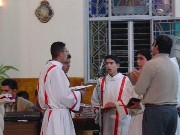 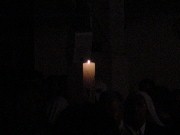 4/14/01:
We took in a late morning at our hotel (check-out was later than usual
because of Passover) before heading out for a lazy lie at the sea.
There's a nip in the air today, a little colder than we were hoping for
on our day at the beach. But that disappointment was soon wiped out
by a nearby Thai food restaurant (ah, how we miss the ol' crib in Chicago
with easy access to Pad Thai). We returned to Zababdeh for "Sabt
in-Nour" - Saturday of Light, the Easter vigil of Holy Saturday.
The service began at 8:00 in darkness as the simple light of a candle entered
the sanctuary. The place was absolutely packed to the rafters (video
- 18 sec.). There was again a great deal of singing, both of Scripture
(audio - 10 sec.) and of hymns (audio
- 22 sec.). Scripture passages were read in the style of a vigil,
beginning with Genesis, recounting the whole story of redemption through
the Revelation. At the end of the service, everyone gathered outside
to wish each other Happy Easter. Because of the Intifada,
the post-vigil celebrations were a bit more subdued than in years past,
we were told. But that didn't stop plenty of fireworks and chocolate and
Easter eggs from being shared. This nighttime vigil was much like the Christmas
Eve services we are used to, which end at midnight with a "Merry Christmas."
Christ is Risen. 4/14/01:
We took in a late morning at our hotel (check-out was later than usual
because of Passover) before heading out for a lazy lie at the sea.
There's a nip in the air today, a little colder than we were hoping for
on our day at the beach. But that disappointment was soon wiped out
by a nearby Thai food restaurant (ah, how we miss the ol' crib in Chicago
with easy access to Pad Thai). We returned to Zababdeh for "Sabt
in-Nour" - Saturday of Light, the Easter vigil of Holy Saturday.
The service began at 8:00 in darkness as the simple light of a candle entered
the sanctuary. The place was absolutely packed to the rafters (video
- 18 sec.). There was again a great deal of singing, both of Scripture
(audio - 10 sec.) and of hymns (audio
- 22 sec.). Scripture passages were read in the style of a vigil,
beginning with Genesis, recounting the whole story of redemption through
the Revelation. At the end of the service, everyone gathered outside
to wish each other Happy Easter. Because of the Intifada,
the post-vigil celebrations were a bit more subdued than in years past,
we were told. But that didn't stop plenty of fireworks and chocolate and
Easter eggs from being shared. This nighttime vigil was much like the Christmas
Eve services we are used to, which end at midnight with a "Merry Christmas."
Christ is Risen. |
 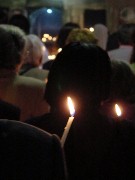  4/15/01:
Al-Masih Qaam. Haaqan Qaam. Christ is Risen. He is Risen
Indeed. Last night was the larger of the Easter services. Today
was no different than the usual Sunday morning Mass, except the service
began with the return of the sanctuary items - the Bible, cross, etc. -
and a brief explanation of their symbolism. There were also a few
more people than usual. Many, many people returned to town from other
parts of Palestine (Ramallah, Bethlehem, Jerusalem) to visit their families
in Zababdeh. After church, we stopped by to visit the Orthodox priest
Abuna To'mie. He was at home resting after the Orthodox Easter vigil,
which begins at 3:00 am and goes until sunrise (about 6:30). After
last night's celebration, though, we couldn't quite convince ourselves
out of bed to attend. Hopefully next year. He gave each of
us an Easter egg, and then informed us that the eggs needed to battle.
This is an Orthodox tradition of some sort, where eggs are tapped tip to
tip. The smashed egg is the loser (we tied, for those of you keeping
score at home). After a traditional Easter meal of lamb and stuffed
grape leaves and squash, we made one final holiday dash off to Jerusalem
to connect with the events at the Holy Sepulchre. We missed most
of the late Saturday/early Sunday moments, but caught an interesting juxtaposition
of Franciscans and Armenians (audio - 18
sec.) processing around the church. The Franciscans prayed together
in monotone Latin chant, the Armenians in Armenian chant. Both seemed
to spend a great deal more time honoring Christ's crucifixion than the
resurrection, which seemed somehow odd given that we had just spent 40
days of Lent focused on the Passion. Al-Masih Qaam! Haaqan
Qaam! 4/15/01:
Al-Masih Qaam. Haaqan Qaam. Christ is Risen. He is Risen
Indeed. Last night was the larger of the Easter services. Today
was no different than the usual Sunday morning Mass, except the service
began with the return of the sanctuary items - the Bible, cross, etc. -
and a brief explanation of their symbolism. There were also a few
more people than usual. Many, many people returned to town from other
parts of Palestine (Ramallah, Bethlehem, Jerusalem) to visit their families
in Zababdeh. After church, we stopped by to visit the Orthodox priest
Abuna To'mie. He was at home resting after the Orthodox Easter vigil,
which begins at 3:00 am and goes until sunrise (about 6:30). After
last night's celebration, though, we couldn't quite convince ourselves
out of bed to attend. Hopefully next year. He gave each of
us an Easter egg, and then informed us that the eggs needed to battle.
This is an Orthodox tradition of some sort, where eggs are tapped tip to
tip. The smashed egg is the loser (we tied, for those of you keeping
score at home). After a traditional Easter meal of lamb and stuffed
grape leaves and squash, we made one final holiday dash off to Jerusalem
to connect with the events at the Holy Sepulchre. We missed most
of the late Saturday/early Sunday moments, but caught an interesting juxtaposition
of Franciscans and Armenians (audio - 18
sec.) processing around the church. The Franciscans prayed together
in monotone Latin chant, the Armenians in Armenian chant. Both seemed
to spend a great deal more time honoring Christ's crucifixion than the
resurrection, which seemed somehow odd given that we had just spent 40
days of Lent focused on the Passion. Al-Masih Qaam! Haaqan
Qaam! |
 4/16/01:
One final relaxed day before heading back to work. We took our time
this morning leaving the comfort of bed, and then slowly made our way to
the Protestant-owned Garden Tomb. Even though its authenticity (as
the site of Christ's crucifiction, burial, and resurrection) is largely
denied by scholars, somehow it seemed very fitting to us to bask there
in the sunshine following Resurrection Sunday. There's a mysterious
calm that is imbued in this place. Leaving Damascus Gate, you get
caught up in all the noise and excitement. Particularly now that
there's extra traffic due to the road construction, the agitation in the
air is palpable. It was extremely soothing and joyful to go from
that chaos to the calm of the Garden, bursting right now with flowers,
aflutter with birds and butterflies. We chatted with many of the
British volunteers who work there in three month stints, as well as with
a Finnish tour group who had spent the entirety of their stay - including
Easter Day - in Tiberias. Tiberias! We know that "He is not here,
for he is risen," but last we checked, he sure wasn't in Tiberias.
We capped off our quiet day of reflection with Boggle and more Thai food
(Elizabeth spelled "pad ped," but Marthame wouldn't count it). 4/16/01:
One final relaxed day before heading back to work. We took our time
this morning leaving the comfort of bed, and then slowly made our way to
the Protestant-owned Garden Tomb. Even though its authenticity (as
the site of Christ's crucifiction, burial, and resurrection) is largely
denied by scholars, somehow it seemed very fitting to us to bask there
in the sunshine following Resurrection Sunday. There's a mysterious
calm that is imbued in this place. Leaving Damascus Gate, you get
caught up in all the noise and excitement. Particularly now that
there's extra traffic due to the road construction, the agitation in the
air is palpable. It was extremely soothing and joyful to go from
that chaos to the calm of the Garden, bursting right now with flowers,
aflutter with birds and butterflies. We chatted with many of the
British volunteers who work there in three month stints, as well as with
a Finnish tour group who had spent the entirety of their stay - including
Easter Day - in Tiberias. Tiberias! We know that "He is not here,
for he is risen," but last we checked, he sure wasn't in Tiberias.
We capped off our quiet day of reflection with Boggle and more Thai food
(Elizabeth spelled "pad ped," but Marthame wouldn't count it). |
   4/17/01:
We were hoping to unload the ol' lemon today, but our connection to sell
it couldn't come through. So we've left it in Jerusalem, in hopes
of returning to sell it another day. N'sha'allah (God willing).
We also cut loose the rental car, first taking it on a spin at the Mount
of Olives, visiting the Garden of Gethsemane and the architecturally
magnificent Church of All Nations with its splendid stained glass and modern
mosaics. We then walked across the ar-Ram checkpoint and into Ramallah
to meet our ride to Zababdeh. After we hopped in, he drove all the
way back to ar-Ram and showed us where he could pick us up next time.
Oh, well. Learning curve, learning curve. We then made our
way back to Zababdeh by the by-roads and the dusty trails, avoiding roadblocks
and bulldozed ways, taking a detour through the Jordan Valley at one point
and through the desert non-roads at another point, following cars that
seemed to know the way. Everything is beginning to turn yellow, as
it hasn't rained in quite a while. The sun has 4/17/01:
We were hoping to unload the ol' lemon today, but our connection to sell
it couldn't come through. So we've left it in Jerusalem, in hopes
of returning to sell it another day. N'sha'allah (God willing).
We also cut loose the rental car, first taking it on a spin at the Mount
of Olives, visiting the Garden of Gethsemane and the architecturally
magnificent Church of All Nations with its splendid stained glass and modern
mosaics. We then walked across the ar-Ram checkpoint and into Ramallah
to meet our ride to Zababdeh. After we hopped in, he drove all the
way back to ar-Ram and showed us where he could pick us up next time.
Oh, well. Learning curve, learning curve. We then made our
way back to Zababdeh by the by-roads and the dusty trails, avoiding roadblocks
and bulldozed ways, taking a detour through the Jordan Valley at one point
and through the desert non-roads at another point, following cars that
seemed to know the way. Everything is beginning to turn yellow, as
it hasn't rained in quite a while. The sun has  been
out which has warmed things, but it means soon the green will no longer
be green. We watched a tractor outside our building ploughing the
hay as birds (mostly cattle egrets and blackbirds) rejoiced at the freshly
pluckable goodies (seeds? insects? grubs?). We, however, turned into
bed to nurse our two colds (one each). been
out which has warmed things, but it means soon the green will no longer
be green. We watched a tractor outside our building ploughing the
hay as birds (mostly cattle egrets and blackbirds) rejoiced at the freshly
pluckable goodies (seeds? insects? grubs?). We, however, turned into
bed to nurse our two colds (one each). |
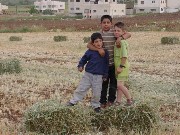 4/18/01:
While we've been gone, harvest time has clearly begun. Apparently
children are the bumper crop here. School began again today after
the break. The kids weren't anxious to return, and neither were we,
but it was good to see all of our teacher friends and hear reports on their
holidays - some variety on fixing the house and lying around. The
irony of Marthame's family traveling hither and yon is that they have far
more freedom than people here do in their own homeland. Elizabeth's
adult class resumed, too, but there were only two students as many people
extended the vacation time by a few days on either side. There hasn't
been any shooting in a while, which is good, though the situation in Gaza
coming across on the television these days doesn't give us much hope. 4/18/01:
While we've been gone, harvest time has clearly begun. Apparently
children are the bumper crop here. School began again today after
the break. The kids weren't anxious to return, and neither were we,
but it was good to see all of our teacher friends and hear reports on their
holidays - some variety on fixing the house and lying around. The
irony of Marthame's family traveling hither and yon is that they have far
more freedom than people here do in their own homeland. Elizabeth's
adult class resumed, too, but there were only two students as many people
extended the vacation time by a few days on either side. There hasn't
been any shooting in a while, which is good, though the situation in Gaza
coming across on the television these days doesn't give us much hope. |
|
4/19/01: After lunch today, we had a wonderful lunch with the Orthodox priest Abuna To'mie and his family. His wife's father was the last Melkite (Greek Catholic) priest, who passed away in 1985, and she directed the government girls' school for thirty years. Before Oslo, the school was under Israeli control. Those must be the bizarre moments of occupation, where one country is directing the schools - even down to the uniforms - of another people's schools. During that time, it was forbidden even to use the word Palestine, and all correspondence from the school had to be written in Hebrew. Her husband was a teacher in Aqaba (a nearby village) for many years. At age fifty, he became the priest of St. George's Orthodox Church of Zababdeh after a two-year apprenticeship under the Greek priest in Nablus. We talked a great deal about possibilities for our work next year. His greatest desire for us is to communication to churches in the West are aware of the presence of Orthodox Christians in Palestine. Thus began our "weekend" (split between Friday and Sunday), as we watched a movie and played cards with some of the other ex-pats here in Zababdeh. |
 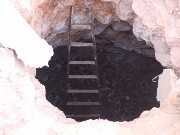 4/21/01:
Today exams have begun for the Tawjihi - 12th grade students. First,
they must do their exams for the school (now), and then they must study
for the comprehensive government exams which will take place in June.
It means that their school year effectively ended before Easter, but their
anxiety is quite palpable. They asked us to pray for them.
Meanwhile, next to our apartment building, work continues on Project "Big
Hole in the Ground" (audio - 5 sec.).
The landlord is digging a water storage well, work beginning at 6:30 in
the morning. The hope is that this will help the water shortage (most
of our building has run out of tap water) in time for summer's heat.
It's certainly adding to the dust factor (which, incidentally, doesn't
need any help). There hasn't been any shooting at night for a long
time, which gives us some respite at least. However, the road in
front of the IDF camp has been blocked off, meaning our monthly drinking
water delivery from Culligan (yes, Culligan) had to go around by way of
Qabatiya and Misilye instead of by way of just Qabatiya (which itself is
a way around the usual road straight from Jenin, effectively blocked for
the last six months) 4/21/01:
Today exams have begun for the Tawjihi - 12th grade students. First,
they must do their exams for the school (now), and then they must study
for the comprehensive government exams which will take place in June.
It means that their school year effectively ended before Easter, but their
anxiety is quite palpable. They asked us to pray for them.
Meanwhile, next to our apartment building, work continues on Project "Big
Hole in the Ground" (audio - 5 sec.).
The landlord is digging a water storage well, work beginning at 6:30 in
the morning. The hope is that this will help the water shortage (most
of our building has run out of tap water) in time for summer's heat.
It's certainly adding to the dust factor (which, incidentally, doesn't
need any help). There hasn't been any shooting at night for a long
time, which gives us some respite at least. However, the road in
front of the IDF camp has been blocked off, meaning our monthly drinking
water delivery from Culligan (yes, Culligan) had to go around by way of
Qabatiya and Misilye instead of by way of just Qabatiya (which itself is
a way around the usual road straight from Jenin, effectively blocked for
the last six months) |
 4/23/01:
Monday, Monday. The strangest thing today - the sky all around became
filled with dust, kind of a yellow fog, like a genuine Lubbock duststorm.
Walking home from school was painful, as dirt swirled along through the
narrow streets. Our building wasn't helped by the big hole in the
ground and the dirt that once filled it (which now filled the air).
Couldn't even see the chicken house outside the back door. Even so,
a couple of fellow ex-pats braved the walk to and from the University to
hang out, pick out a few "Rise Up Singing" selections, and wonder about
next year's plans-hopes-dreams. Quiet, culturally familiar, and folkie. 4/23/01:
Monday, Monday. The strangest thing today - the sky all around became
filled with dust, kind of a yellow fog, like a genuine Lubbock duststorm.
Walking home from school was painful, as dirt swirled along through the
narrow streets. Our building wasn't helped by the big hole in the
ground and the dirt that once filled it (which now filled the air).
Couldn't even see the chicken house outside the back door. Even so,
a couple of fellow ex-pats braved the walk to and from the University to
hang out, pick out a few "Rise Up Singing" selections, and wonder about
next year's plans-hopes-dreams. Quiet, culturally familiar, and folkie. |
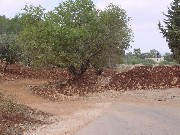 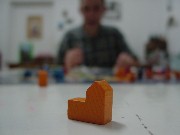 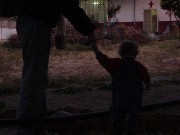 4/26/01:
Headed to Jenin today to run a few errands, get out of the village for
a few hours, and check out the bootlegged software. The latter is
as rampant here as the persistent Israeli roadblocks (neither, it turns
out, complies with international law). After school it was a chance
to relax as the half-weekend begins. We went to the Latin Church's
Youth Group meeting, where we understood little except that the topic of
discussion was Purgatory. The one word we could pick out of the Arabic
text they were reading was Calvin - apparently talking about his and Luther's
rejection of the concept. Just a little reminder of the challenges
that remain in ecumenical dialogue, perhaps. Afterwards we wandered
over to visit the French volunteers, tuck their children into bed, and
play Siedler into the wee hours of the morning - the German game's goals
of settlement-planting, road-building, and resource-hoarding remain as
ironic in this context as ever. 4/26/01:
Headed to Jenin today to run a few errands, get out of the village for
a few hours, and check out the bootlegged software. The latter is
as rampant here as the persistent Israeli roadblocks (neither, it turns
out, complies with international law). After school it was a chance
to relax as the half-weekend begins. We went to the Latin Church's
Youth Group meeting, where we understood little except that the topic of
discussion was Purgatory. The one word we could pick out of the Arabic
text they were reading was Calvin - apparently talking about his and Luther's
rejection of the concept. Just a little reminder of the challenges
that remain in ecumenical dialogue, perhaps. Afterwards we wandered
over to visit the French volunteers, tuck their children into bed, and
play Siedler into the wee hours of the morning - the German game's goals
of settlement-planting, road-building, and resource-hoarding remain as
ironic in this context as ever. |
 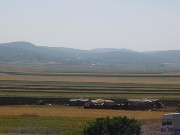 4/27/01:
Went for a picnic in the nearby hills with some contemporaries - late twenties,
early thirties professionals who live and work in Zababdeh and Jenin, both
Muslim and Christian. Like most such picnics, it included barbequed
lamb and chicken, hummos, taboule, and lots and lots of singing.
Interesting conversations, too, about village life, gender relationships,
and language. It was nice to find folks here who are our age but
don't have children yet - somewhat counter-cultural in Palestinian village
life. Eventually, the sounds of training from the Israeli camp began
to echo through the late-afternoon air - time to leave. The rainy
season appears to be nearing the end and the local Bedouins have
returned to the fields (note to self: get fresh cheese soon). 4/27/01:
Went for a picnic in the nearby hills with some contemporaries - late twenties,
early thirties professionals who live and work in Zababdeh and Jenin, both
Muslim and Christian. Like most such picnics, it included barbequed
lamb and chicken, hummos, taboule, and lots and lots of singing.
Interesting conversations, too, about village life, gender relationships,
and language. It was nice to find folks here who are our age but
don't have children yet - somewhat counter-cultural in Palestinian village
life. Eventually, the sounds of training from the Israeli camp began
to echo through the late-afternoon air - time to leave. The rainy
season appears to be nearing the end and the local Bedouins have
returned to the fields (note to self: get fresh cheese soon). |
 4/28/01:
Since we've been nursing our colds, we haven't had a chance to do as much
visiting as is the norm for the village. Particularly around Easter
time, visiting is of primary importance - going to wish members of your
family "Happy Easter," bearing gifts of sweets (especially date-filled
holiday cookies) is a required activity. Since we don't have any
blood family here, we get a grace period - but not too long! We caught
up with some of the families who plied us with coffee and simple Arabic
early on - good to reconnect. We also continued talking about possible
projects for the coming years in Zababdeh. We are hoping to take
a trip to Haifa with one of Zababdeh's residents to move one of them along.
Unfortunately, getting out of the West Bank for Palestinians is next to
impossible, even if you have official government permission to work or
travel. Technology won't work as a substitute for some things.
A piece of good news - an article we wrote (along with some of our photos)
for Christian Century
will be appearing as next month's feature piece. Cool! 4/28/01:
Since we've been nursing our colds, we haven't had a chance to do as much
visiting as is the norm for the village. Particularly around Easter
time, visiting is of primary importance - going to wish members of your
family "Happy Easter," bearing gifts of sweets (especially date-filled
holiday cookies) is a required activity. Since we don't have any
blood family here, we get a grace period - but not too long! We caught
up with some of the families who plied us with coffee and simple Arabic
early on - good to reconnect. We also continued talking about possible
projects for the coming years in Zababdeh. We are hoping to take
a trip to Haifa with one of Zababdeh's residents to move one of them along.
Unfortunately, getting out of the West Bank for Palestinians is next to
impossible, even if you have official government permission to work or
travel. Technology won't work as a substitute for some things.
A piece of good news - an article we wrote (along with some of our photos)
for Christian Century
will be appearing as next month's feature piece. Cool! |
   4/29/01:
A beautiful, beautiful day! We went to worship at St. Matthew's Anglican
Church, then went with Father Hossam to see his other parish (he has two
in addition to responsibilities at a school, a hospital, and a health clinic)
down in the Raffidiye neighborhood of Nablus. This once-separate
village has become part of Nablus' energetic urban sprawl. The area
is still home to most of Nablus' 700 Christians (the whole city is about
150,000) - most of the people with whom we talked made it clear that their
plight as Christians is intertwined with that of the rest of the city.
We also got our long-awaited chance to play tourist to Nablus' holy sites.
Nablus has an incredible energy to it. It's the largest Arab city
on the West Bank and hasn't become quite as cosmopolitan as Ramallah has.
As a result, it has retained much of its Eastern charm, hospitality, mystery,
and activity. Unfortunately, it is bordered by Israeli settlements
(Elon More is the most well-known and visible), meaning that the city has
been cut off and bombarded, too. Even so, it seemed a world
away from Zababdeh. Our first stop was Jacob's Well, where the patriarch
purchased land (Genesis 33) and Jesus met the Samaritan woman (John 4).
Father Justinus, a Greek-born Orthodox priest, has been laboring by hand
on the church's magnificent stone work for many years. 4/29/01:
A beautiful, beautiful day! We went to worship at St. Matthew's Anglican
Church, then went with Father Hossam to see his other parish (he has two
in addition to responsibilities at a school, a hospital, and a health clinic)
down in the Raffidiye neighborhood of Nablus. This once-separate
village has become part of Nablus' energetic urban sprawl. The area
is still home to most of Nablus' 700 Christians (the whole city is about
150,000) - most of the people with whom we talked made it clear that their
plight as Christians is intertwined with that of the rest of the city.
We also got our long-awaited chance to play tourist to Nablus' holy sites.
Nablus has an incredible energy to it. It's the largest Arab city
on the West Bank and hasn't become quite as cosmopolitan as Ramallah has.
As a result, it has retained much of its Eastern charm, hospitality, mystery,
and activity. Unfortunately, it is bordered by Israeli settlements
(Elon More is the most well-known and visible), meaning that the city has
been cut off and bombarded, too. Even so, it seemed a world
away from Zababdeh. Our first stop was Jacob's Well, where the patriarch
purchased land (Genesis 33) and Jesus met the Samaritan woman (John 4).
Father Justinus, a Greek-born Orthodox priest, has been laboring by hand
on the church's magnificent stone work for many years.  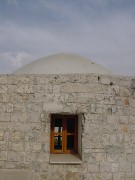 The
roof gave us both acrophobia and tremendous views of the city (video
- 13 sec.). We then headed to Joseph's tomb, where this patriarch's
body was laid to rest after being brought back from Egypt (Joshua 24).
It is a site holy to Jews, Muslims, and Christians. Early in the
Intifada,
it was a flash-point. The Israeli army eventually abandoned it, and
scenes of it being burned, its roof being painted green (a frequently-used
color in Islam) and its stones being torn down by Palestinians covered
the news. It was shown as evidence of what disastrous things could
happen if the PA were left in charge of such places. Today, the place
looks pristine - its roof has been re-painted white (since its status remains
to be negotiated), its stone-work and windows have all been replaced.
Also gone (video - 11 sec.) is the Israeli
military presence which surrounded the Tomb with a military barracks and
barbed-wire enclosed no-man's land. Since its still under negotiation,
visitors aren't generally allowed in, but we were able to convince the
policeman on duty to ask his superiors if some
Ajanib (foreigners)
could sneak a peek. We then drove up to see Nablus' Samaritan community.
Numbering about 500 (around 300 still in Nablus, and 200ish in a part of
Tel Aviv), Samaritans are a branch of Judaism that accepts only the Torah
(the first five books), recognize Mt. Gerizim (where they live) as the
holiest place in the land, and continue to sacrifice animals on Passover.
They have also, throughout The
roof gave us both acrophobia and tremendous views of the city (video
- 13 sec.). We then headed to Joseph's tomb, where this patriarch's
body was laid to rest after being brought back from Egypt (Joshua 24).
It is a site holy to Jews, Muslims, and Christians. Early in the
Intifada,
it was a flash-point. The Israeli army eventually abandoned it, and
scenes of it being burned, its roof being painted green (a frequently-used
color in Islam) and its stones being torn down by Palestinians covered
the news. It was shown as evidence of what disastrous things could
happen if the PA were left in charge of such places. Today, the place
looks pristine - its roof has been re-painted white (since its status remains
to be negotiated), its stone-work and windows have all been replaced.
Also gone (video - 11 sec.) is the Israeli
military presence which surrounded the Tomb with a military barracks and
barbed-wire enclosed no-man's land. Since its still under negotiation,
visitors aren't generally allowed in, but we were able to convince the
policeman on duty to ask his superiors if some
Ajanib (foreigners)
could sneak a peek. We then drove up to see Nablus' Samaritan community.
Numbering about 500 (around 300 still in Nablus, and 200ish in a part of
Tel Aviv), Samaritans are a branch of Judaism that accepts only the Torah
(the first five books), recognize Mt. Gerizim (where they live) as the
holiest place in the land, and continue to sacrifice animals on Passover.
They have also, throughout  the
years of occupation and the Intifadas, remained on good terms with
the Palestinians of Nablus. They also have a breathtaking view of
Nablus (video - 13 sec.), as it continues
to spread up and down through the valley. After seeing the 100 year-old
St. Luke's Hospital (where our Dutch Nablus hostess works), eating shawarma
in a beautiful city park (where we were the object of much curiosity),
walking through Nablus' Old City, talking about ministry in Zababdeh with
Father Hossam, and visiting (and drinking coffee with) several families,
we returned to the Anglican "compound" at the edge of the Old City to sing
a few hymns and share a few laughs. A beautiful, beautiful day. the
years of occupation and the Intifadas, remained on good terms with
the Palestinians of Nablus. They also have a breathtaking view of
Nablus (video - 13 sec.), as it continues
to spread up and down through the valley. After seeing the 100 year-old
St. Luke's Hospital (where our Dutch Nablus hostess works), eating shawarma
in a beautiful city park (where we were the object of much curiosity),
walking through Nablus' Old City, talking about ministry in Zababdeh with
Father Hossam, and visiting (and drinking coffee with) several families,
we returned to the Anglican "compound" at the edge of the Old City to sing
a few hymns and share a few laughs. A beautiful, beautiful day. |
  4/30/01:
Chapter one of the long, tedious car saga is drawing to a close.
As Elizabeth headed back to Zababdeh to teach, Marthame headed down to
Jerusalem hoping that the car was still where we had left it (and half-hoping
it had been stolen - an insurance claim might be easier at this point in
time). The journey took three hours by backroads around checkpoints
and closures, and the car was still there. It only took twenty minutes
for it to start, and Marthame drove it to Ramallah to leave it with the
mechanic to do final maintenance and sell it. Now, even though we
don't have the money for it yet, the car is no longer our headache!
He then picked up a rental car (from one of the two companies that're insured
for West Bank driving) and headed home. Along the way, he passed the rubble
that once was the Palestinian police station in Ramallah. After the
lynching of two Israeli soldiers in its prison, the place was leveled -
and has remained so. In the Jordan Valley, it was the sight of Jericho's
complete encirclement. All roads entering have been blockaded, and
an anti-tank trench has been dug around the city. The rest of the
drive passed without incident, 4/30/01:
Chapter one of the long, tedious car saga is drawing to a close.
As Elizabeth headed back to Zababdeh to teach, Marthame headed down to
Jerusalem hoping that the car was still where we had left it (and half-hoping
it had been stolen - an insurance claim might be easier at this point in
time). The journey took three hours by backroads around checkpoints
and closures, and the car was still there. It only took twenty minutes
for it to start, and Marthame drove it to Ramallah to leave it with the
mechanic to do final maintenance and sell it. Now, even though we
don't have the money for it yet, the car is no longer our headache!
He then picked up a rental car (from one of the two companies that're insured
for West Bank driving) and headed home. Along the way, he passed the rubble
that once was the Palestinian police station in Ramallah. After the
lynching of two Israeli soldiers in its prison, the place was leveled -
and has remained so. In the Jordan Valley, it was the sight of Jericho's
complete encirclement. All roads entering have been blockaded, and
an anti-tank trench has been dug around the city. The rest of the
drive passed without incident, 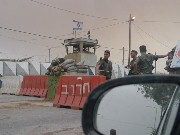 but
as he got closer to the Jalame checkpoint, the sky took on a dark, creepy,
orange glow. Then it began to rain - not water, but mud! The
sky had filled with dust, as it did a week ago (something about Mondays),
and the rain brought it down to earth - nothing like a good rainshower
to get your car dirty. Once he reached Jalame, though, there was
a backlog of traffic as well as an escalated police presence. Apparently
a shooting had happened a half hour previous to his arrival (not unlike
Marthame's parents' first visit), and the checkpoint was closed - to everyone
except Ganim and Kadim's settlers. Which begs the question: why was
it closed? Chalk it up to the list of the mysteries of this land.
Needless to say, the return trip passed without incident. but
as he got closer to the Jalame checkpoint, the sky took on a dark, creepy,
orange glow. Then it began to rain - not water, but mud! The
sky had filled with dust, as it did a week ago (something about Mondays),
and the rain brought it down to earth - nothing like a good rainshower
to get your car dirty. Once he reached Jalame, though, there was
a backlog of traffic as well as an escalated police presence. Apparently
a shooting had happened a half hour previous to his arrival (not unlike
Marthame's parents' first visit), and the checkpoint was closed - to everyone
except Ganim and Kadim's settlers. Which begs the question: why was
it closed? Chalk it up to the list of the mysteries of this land.
Needless to say, the return trip passed without incident. |
|
|